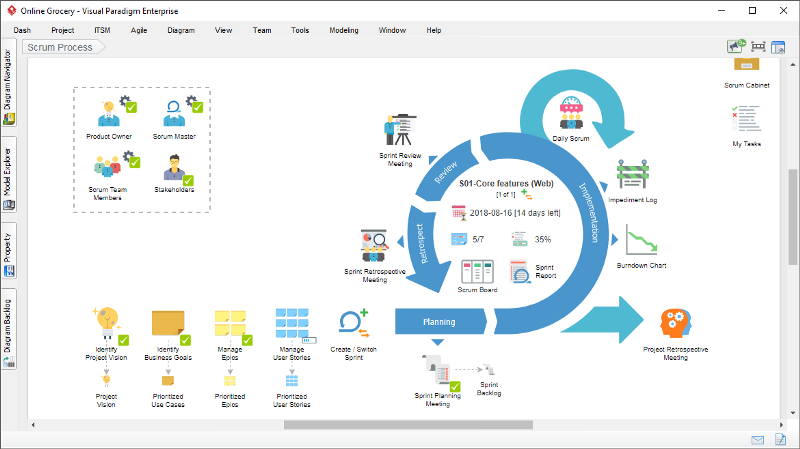
Agile adalah pendekatan iteratif untuk pengembangan produk perangkat lunak. Ini membantu tim proyek memberikan nilai kepada pelanggan mereka lebih cepat dan lebih baik. Salah satu prinsip agile yang kunci adalah menyampaikan pekerjaan dalam skala kecil, dapat diuji, dan dapat dikelola. Alih-alih identifikasi kebutuhan di awal, agile menekankan penemuan dan identifikasi kebutuhan yang berkelanjutan sepanjang proyek. Tim agile dapat bereaksi terhadap perubahan lebih cepat dan lebih mudah.
Apa yang dibahas dalam tutorial agile ini?
Ini adalah tutorial scrum agile langkah demi langkah yang membantu Anda memahami konsep inti pengembangan agile serta cara bagaimana proyek agile dapat dilaksanakan dari awal hingga akhir (yaitu pengiriman produk). Perangkat lunak agile Kanvas Proses Scrumakan digunakan sepanjang tutorial ini. Seluruh tutorial scrum agile akan mencakup berbagai topik agile dan disarankan agar pembaca membaca tutorial scrum ini secara berurutan untuk sepenuhnya memahami alur pengembangan proyek agile.
Sasaran audiens tutorial agile
Tutorial agile ini ditulis untuk orang-orang di bawah ini.
- Orang-orang yang sedang bekerja atau akan bekerja pada proyek agile, misalnya semua jenis pengembang perangkat lunak, programmer, penguji, desainer UX, arsitek, dll.
- Manajer proyek dan scrum master
- Pemilik produk, analis bisnis dan perwakilan pelanggan
- Unit yang mengatur proyek scrum
Garis besar tutorial scrum agile
Ada total dua puluh pelajaran yang dibahas dalam tutorial agile ini. Klik pada kuliah untuk memulai.
Pelajaran 01 — Cara Mengidentifikasi Visi Proyek
- Identifikasi visi proyek
- Kembangkan Piagam Proyek Agile
Pelajaran 02 — Cara Menunjuk Pemilik Produk
- Tunjuk pemilik produk
- Rincian tanggung jawab pemilik produk
Pelajaran 03 — Cara Menunjuk Scrum Master
- Tunjuk scrum master
- Rincian tanggung jawab scrum master
Pelajaran 04 — Cara Membentuk Tim Scrum
- Pilih anggota tim scrum
- Rincian tanggung jawab anggota tim scrum
Pelajaran 05 — Cara Mengidentifikasi Pemangku Kepentingan Proyek Scrum
- Daftar pemangku kepentingan proyek scrum
- Deskripsikan pemangku kepentingan
Pelajaran 06 — Cara Mengidentifikasi Tujuan Bisnis
- Gambar diagram use case
- Deskripsikan use case
Pelajaran 07 — Cara Mengelola Epik
- Buat epik dalam peta cerita pengguna
- Deskripsikan epik
Pelajaran 08 — Cara Mengelola Backlog Produk
- Deskripsikan kriteria selesai proyek scrum
- Buat cerita pengguna dalam peta cerita
- Tentukan kriteria penerimaan
- Prioritaskan cerita pengguna
Pelajaran 09 — Cara Mengembangkan Rencana Rilis
- Identifikasi dan deskripsikan hasil proyek
- Daftar rilis proyek
- Susun kembali cerita pengguna ke dalam rilis
Pelajaran 10 — Cara Membuat Sprint
- Buat sprint
- Konfigurasi sprint
Pelajaran 11 — Cara Melakukan Rapat Perencanaan Sprint
- Pilih cerita pengguna untuk backlog sprint
- Identifikasi tugas yang diperkirakan usaha
- Identifikasi hasil sprint
Pelajaran 12 — Cara Mencatat Hambatan
- Catat hambatan
- Rincikan hambatan
Pelajaran 13 — Cara Membuat Grafik Burndown
- Pahami grafik burndown
- Buka grafik burndown
Pelajaran 14 — Cara Membuat Papan Scrum
- Pahami papan scrum
- Buka papan scrum
Pelajaran 15 — Cara Melakukan Scrum Harian
- Catat kemajuan pekerjaan
- Lakukan scrum harian
- Catat aktivitas tindak lanjut
Pelajaran 16 — Cara Melakukan Tinjauan Sprint
- Demonstrasikan cerita pengguna
- Lakukan penerimaan cerita pengguna
- Perbarui kemajuan hasil proyek
Pelajaran 17 — Cara Melakukan Retrospektif Sprint
- Catat item mulai, lanjutkan, dan berhenti
- Beri suara dan catat hasil pemungutan suara
Pelajaran 18 — Cara Melakukan Retrospektif Proyek
- Dokumentasikan pelajaran yang dipelajari — keberhasilan proyek
- Dokumentasikan tantangan proyek
Pelajaran 19 — Cara Menghasilkan Laporan untuk Proyek Scrum
- Buka laporan yang dihasilkan secara otomatis
- Generasi laporan manual
Pelajaran 20 — Cara Menggunakan Pintasan Artefak
- Buka artefak melalui pintasan
This post is also available in Deutsch, English, Español, فارسی, Français, 日本語, Polski, Portuguese, Ру́сский, Việt Nam, 简体中文 and 繁體中文.













